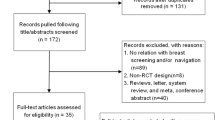Abstract
Delay in follow-up after an abnormal mammogram is associated with advanced disease stage, poorer survival, and increased anxiety. Despite the implementation of many patient navigator programs across the country, there are few published, peer-reviewed studies documenting its effectiveness. We tested the effectiveness of a patient navigator in improving timeliness to diagnosis, decreasing anxiety, and increasing satisfaction in urban minority women after an abnormal mammogram. Women with suspicious mammograms were randomly assigned to usual care (N = 50) or usual care plus intervention with a patient navigator (N = 55). There were no demographic differences between the two groups. Women in the intervention group had shorter times to diagnostic resolution (mean 25.0 vs. 42.7 days; p = .001), with 22% of women in the control group without a final diagnosis at 60 days vs. 6% in the intervention group. The intervention group also had lower mean anxiety scores (decrease of 8.0 in intervention vs. increase of 5.8 in control; p < .001), and higher mean satisfaction scores (4.3 vs. 2.9; p < .001). Patient navigation is an effective strategy to improve timely diagnostic resolution, significantly decrease anxiety, and increase patient satisfaction among urban minority women with abnormal mammograms.


Similar content being viewed by others
References
Jemal A, Siegel R, Ward E, Murray T, Xu J, Thun MJ. Cancer Statistics, 2007. CA Cancer J Clin. 2007;57(1):43–66.
Center for Disease Control and Prevention. The National Breast and Cervical Cancer Early Detection Program: Saving Lives Through Screening—2006 Program Fact Sheet. Available at: http://www.cdc.gov/cancer/nbccedp/about.htm. Accessed December 2006.
Hunter CP. Epidemiology, stage at diagnosis, and tumor biology of breast carcinoma in multiracial and multiethnic populations. Cancer. 2000;88(5 Suppl):1193–1202.
Kothari A, Fentiman IS. Diagnostic delays in breast cancer and impact on survival. Int J Clin Pract. 2003;57(3):200–203.
Heckman BD, Fisher EB, Monsees B, Merbaum M, Ristvedt S, Bishop C. Coping and anxiety in women recalled for additional diagnostic procedures following an abnormal screening mammogram. Health Psychol. 2004;23(1):42–48.
Dohan D, Schrag D. Using navigators to improve care of underserved patients: current practices and approaches. Cancer. 2005;104(4):848–855.
Freeman HP, Muth BJ, Kerner JF. Expanding access to cancer screening and clinical follow-up among the medically underserved. Cancer Pract. 1995;3(1):19.
Weinrich SP, Boyd MD, Weinrich M, Greene F, Reynolds WA, Jr., Metlin C. Increasing prostate cancer screening in African American men with peer-educator and client-navigator interventions. J Cancer Educ. 1998;13(4):213–219.
Tingen MS, Weinrich SP, Heydt DD, Boyd MD, Weinrich MC. Perceived benefits: a predictor of participation in prostate cancer screening. Cancer Nurs. Oct 1998;21(5):349–357.
Frelix GD, Rosenblatt R, Solomon M, Vikram B. Breast cancer screening in underserved women in the Bronx. J Natl Med Assoc. 1999;91(4):195–200.
Ell K, Padgett D, Vourlekis B, et al. Abnormal mammogram follow-up: a pilot study women with low income. Cancer Pract. 2002;10(3):130–138.
Ell K, Vourlekis B, Muderspach L, et al. Abnormal cervical screen follow-up among low-income Latinas: Project SAFe. Journal of Womens Health and Gender-Based Med. 2002;11(7):639–651.
Psooy BJ, Schreuer D, Borgaonkar J, Caines JS. Patient navigation: improving timeliness in the diagnosis of breast abnormalities. Can Assoc Radiol J. 2004;55(3):145–150.
Dignan MB, Burhansstipanov L, Hariton J, et al. A comparison of two Native American Navigator formats: face-to-face and telephone. Cancer Control. Nov 2005;12(Suppl 2):28–33.
Jandorf L, Gutierrez Y, Lopez J, Christie J, Itzkowitz SH. Use of a patient navigator to increase colorectal cancer screening in an urban neighborhood health clinic. J Urban Health. 2005;82(2):216–224.
Nash D, Azeez S, Vlahov D, Schori M. Evaluation of an intervention to increase screening colonoscopy in an urban public hospital setting. J Urban Health. 2006;83(2):231–243.
Battaglia TA, Roloff K, Posner MA, Freund KM. Improving follow-up to abnormal breast cancer screening in an urban population. Cancer. 2007;109(S2):359–367.
Ell K, Vourlekis B, Lee P-J, Xie B. Patient navigation and case management following an abnormal mammogram: a randomized clinical trial. Prev Med. 2007;44(1):26.
Zung WK. A rating instrument for anxiety disorders. Psychosomatics. 1971;12(6):371–384.
Hendriks AAJ, Oort FJ, Vrielink MR, Smets EMA. Reliability and validity of the Satisfaction with Hospital Care Questionnaire. Int J Qual Health Care. 2002;14(6):471–482.
Centers for Disease Control and Prevention. Annual performance plan and report 2004. Atlanta, GA: Centers for Disease Control and Prevention; 1994.
Acknowledgment
This patient navigation program was funded by the Susan G. Komen Foundation North Jersey Affiliate.
Author information
Authors and Affiliations
Corresponding author
Rights and permissions
About this article
Cite this article
Ferrante, J.M., Chen, PH. & Kim, S. The Effect of Patient Navigation on Time to Diagnosis, Anxiety, and Satisfaction in Urban Minority Women with Abnormal Mammograms: A Randomized Controlled Trial. J Urban Health 85, 114–124 (2008). https://doi.org/10.1007/s11524-007-9228-9
Received:
Accepted:
Published:
Issue Date:
DOI: https://doi.org/10.1007/s11524-007-9228-9




